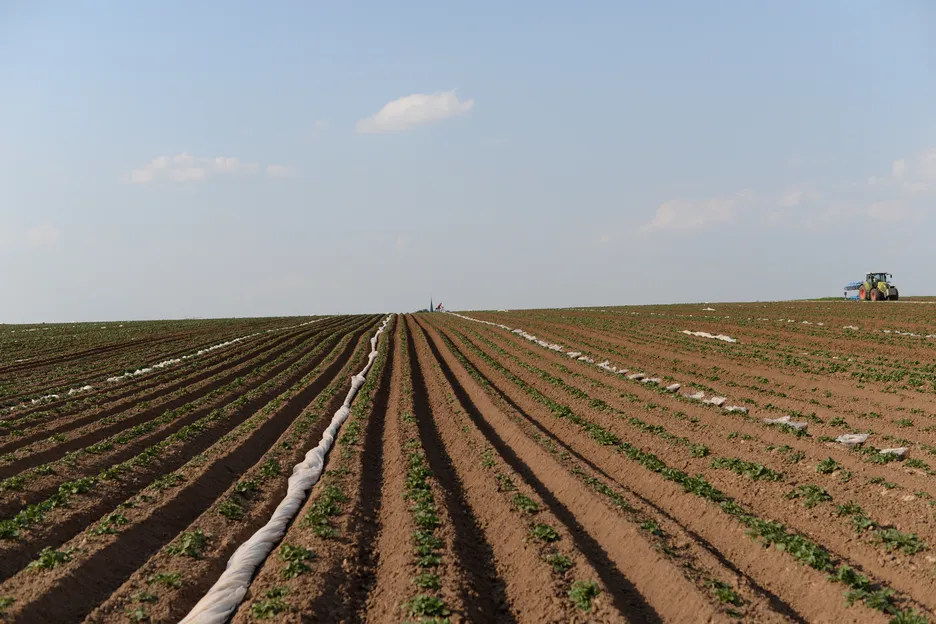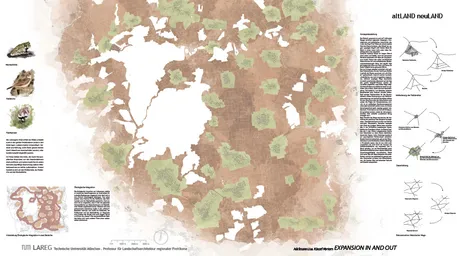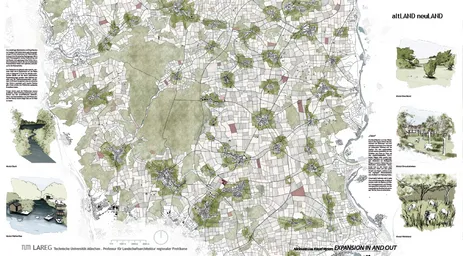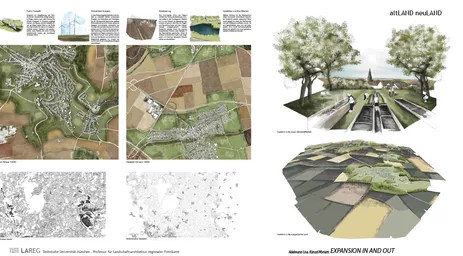Design
In the phase of design, a regional landscape or a 'regional' topic is chosen for the landscape. Based on a spatial structure and shape, overarching designs are developed.
altLAND neuLAND

Beyond the European city, as well, a new social contract on the structure, function and form of space is overdue, and within it a new understanding of landscape as a structuring element.
A large part of the population lives in suburban areas, the in-between city (SIEVERTS 1997). In growing regions such as Munich and Berlin, half of the increase in population is accounted for by the peripheries close to the big cities. For a qualification of suburban spaces, crystallisation cores are needed that can be charged as identity-creating, significant places and can be qualified as condensed or also emphatically open centres. Where urban cores and "primary elements" (ROSSI 1973) are missing, such structural elements can be relict elements of the natural or cultural landscape, such as bodies of water, gardens, parks, village centres, paths or field structures.
Another large part of the population lives in so-called rural areas, but is also developing modern lifestyles and needs there today - not as an accident or waste of urbanisation, rather as a consistent consequence of a general urbanisation process (LEFÈBVRE 1972), but also as a "survival principle" for the countryside itself, since due to demographic change, the continued settlement of structurally weaker regions is tied to the two factors of work and landscape quality, in order to be attractive for immigrants of the knowledge society and global migrations. However, the qualities of everyday life in small and medium-sized towns are much more strongly linked to landscape than in the large cities.
INTRODUCTION.
The International Exhibition for Building in Berlin 1987 was characterised by Critical Reconstruction (IBA New Building) and Cautious Renovation (IBA Old Building). During the IBA-Neubau, new building projects were implemented that were oriented towards historical structures of the city layout. During IBA-Altbau, urban renewal focused on the repair and modernisation of existing buildings and thus also on the preservation, stabilisation and further development of existing social and functional structures.
In the bachelor project altLAND neuLAND, this idea is to be transferred to the landscape. The Maindreieck, the area surrounding Würzburg, is characterised by large-scale agriculture. The use of groundwater for irrigation is reaching its natural limit, also due to climate change, which leads to conflicts with the municipal drinking water supply. In accordance with the specifications of the IBA-Neubau, new landscape structures are to be designed that make the landscape more sustainable ecologically, but above all also in terms of a holistic view from a social and aesthetic perspective.
The Frankenwald, on the other hand, is confronted with social issues of migration and depopulation - which culminate in an abandonment of agricultural use. According to the principles of IBA-Altbau, the existing small-scale structure and farming practice must be transformed into an economically viable form without destroying the existing 'diversity, uniqueness and beauty' of the landscape.
QUESTION.
altLAND - Frankenwald
How can the peripheral rural Frankenwald be carefully developed against the background of depopulation and changes in agriculture, while at the same time preserving its landscape characteristics and rural settlement structures?
neuLAND - Fränkische Gäuplatten
On the other hand, how should the suburban landscape space bordering Würzburg do justice to its identity-creating role by means of a design approach guided by the principles of Critical Reconstruction, without bowing to the paradigm of functional separation in the landscape?


